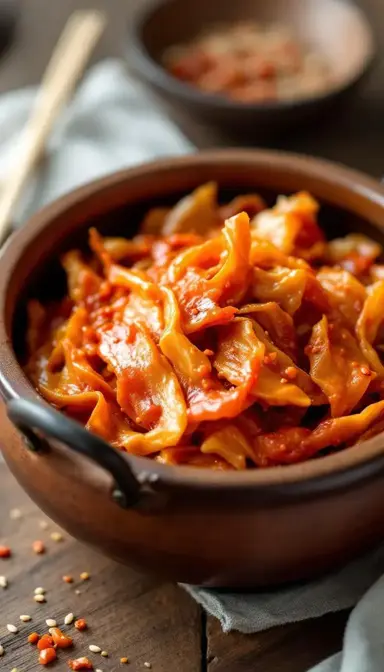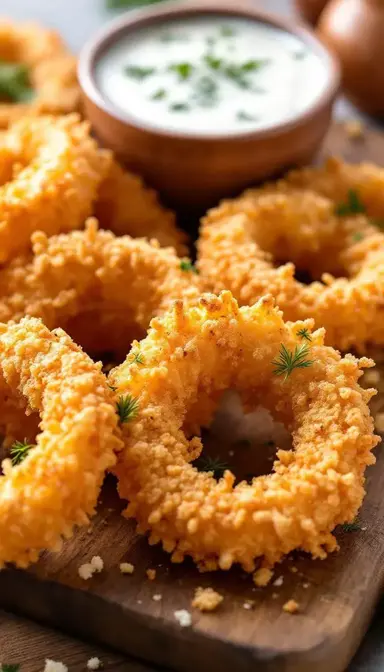There’s something magical about kimchi—the way it starts as humble cabbage and transforms into a riot of spicy, tangy, umami-packed goodness. I still remember my first bite of properly fermented kimchi at a tiny Seoul street stall. The crunch, the heat, the deep funk that lingers on your tongue—it was love at first taste. Now, after years of tweaking my own recipe (and a few failed batches that taught me patience), I’m sharing the secrets to crafting kimchi that’ll make your taste buds dance.
Why This Recipe Works
- Living Food: Unlike static condiments, kimchi evolves in your fridge like a fine wine, developing deeper flavors week by week.
- Kitchen Alchemy: That moment when the garlic, ginger, and gochugaru paste hits the brined cabbage? Pure culinary sorcery.
- Gut-Loving Goodness: Each bite delivers probiotics that’ll make your digestive system sing hallelujah.
Essential Ingredients & Tools
Ingredients
- 1 large napa cabbage (~5 lbs): Look for tightly packed heads with crisp, pale green leaves—avoid any with brown spots.
- ½ cup kosher salt: Diamond Crystal is my go-to; its flaky crystals distribute evenly without over-salting.
- ¼ cup gochugaru (Korean chili flakes): These aren’t just heat—they bring a smoky sweetness you can’t replicate with cayenne. (Pro tip: Buy them in bulk at Asian markets. No gochugaru? Use 2 tbsp cayenne + 2 tbsp smoked paprika for a milder version.)
- ¼ cup fish sauce: Three Crabs brand is my kitchen MVP for that perfect umami punch. Vegetarian? Swap in 3 tbsp soy sauce + 1 tbsp miso.
- 2 tbsp minced garlic: Don’t even think about pre-minced jars—fresh cloves are non-negotiable.
- 1 tbsp grated ginger: Microplane it right into the bowl to capture every drop of zesty juice.
- 1 tbsp sugar: Balances acidity; honey or maple syrup work too.
- 1 cup julienned daikon radish: Adds crunch; sub with carrots if needed.
- 4 chopped scallions: Use both white and green parts for layered flavor.
Tools
- Large mixing bowl: For brining and mixing.
- Colander: Drains excess liquid from cabbage.
- Disposable gloves: Unless you enjoy chili-burned fingertips for days.
- Glass jars or fermentation crock: Wide-mouth Mason jars work perfectly.
How to Make The Art of Homemade Kimchi
The Salt Bath
Slice your 1 large napa cabbage (~5 lbs) lengthwise into quarters, keeping the core intact—it’s nature’s handle for spreading leaves. Massage ½ cup kosher salt between every layer, paying extra attention to the thick white ribs. Submerge in cool water and let it soak for 1–2 hours. This isn’t just about seasoning—the brine pulls out excess water so your kimchi stays crisp instead of turning to mush. Rinse thoroughly under cold water and squeeze out excess liquid.
Crafting the Paste
In a bowl, whisk together ¼ cup gochugaru, ¼ cup fish sauce, 2 tbsp minced garlic, 1 tbsp grated ginger, and 1 tbsp sugar. The mixture should look like lava—thick, glistening, and dangerously aromatic. Let it rest 10 minutes; the sugar will dissolve and the flavors will marry. For a smoother paste, add a splash of reserved cabbage brine or water.
The Messy Magic
Slather the paste onto every leaf crevice. Wear gloves and massage that ruby-red goodness into the cabbage, 1 cup julienned daikon radish, and 4 chopped scallions until everything’s evenly coated. The scent will make your kitchen smell like your favorite Korean BBQ joint.
Fermentation Tango
Pack the kimchi into jars, pressing down firmly to eliminate air pockets. Leave 1 inch of headspace at the top—those bubbles need room to party. Let it ferment at room temperature (65–75°F) for 2 days, burping the jars daily to prevent explosions. Then transfer to the fridge. The flavor will keep developing; I prefer mine at the 2-week mark when it’s tangy but still has a bright kick.
Chef’s Wisdom
Texture is Everything
If your kimchi turns out softer than you’d like:
- Cut brining time to 1 hour.
- Add extra daikon or carrots for structural support.
- Pack jars gently—think “tucking in a baby” not “stuffing a suitcase.”
The Flavor Timeline
- Days 1-3: Bright and aggressive, perfect for kimchi grilled cheese.
- Weeks 2-4: Mellowed tang, ideal for stews or fried rice.
- Month 2+: Funky and profound—reserved for kimchi jjigae or brave taste buds.
When Things Go Wrong
See white fuzz? Scoop it off—the kimchi beneath is fine. Pink or green mold? Toss it. Too salty? Rinse briefly before using, or balance it with sugar in cooked dishes.
Perfect Pairings
Complementary Dishes
- Kimchi Jjigae (Stew): The fermented tang of aged kimchi balances rich pork or tofu in this hearty stew. Simmer until the flavors meld for ultimate comfort food.
- Kimchi Pancakes: Crispy edges and soft centers make these savory pancakes a textural delight. Serve with a soy-vinegar dipping sauce.
Drinks
- Off-Dry Riesling: Its slight sweetness counters kimchi’s spice, while acidity cleanses the palate.
- Makgeolli (Korean Rice Wine): This milky, lightly effervescent drink complements kimchi’s funk.
Something Sweet
- Grilled Pineapple: Caramelized fruit cools the palate with juicy sweetness.
- Matcha Ice Cream: Bitter matcha contrasts kimchi’s heat, creating a refreshing finish.
Chef’s Wisdom
Kimchi isn’t just food—it’s a living tradition. Every batch tells a story through its evolving flavors. My third attempt turned out so fiery it made my neighbor cough from across the hallway, while batch #7 was so perfect I ate it straight from the jar with a spoon. Yours will have its own personality too. Embrace the process, taste fearlessly, and let those microbes work their magic.
Now if you’ll excuse me, I’ve got a 3-week-old jar calling my name…

The Art of Homemade Kimchi: A Fermented Love Letter to Korean Flavors
Learn how to make authentic homemade kimchi with my step-by-step guide. Packed with probiotics and bold flavor, it's the ultimate fermented condiment. Start fermenting today!
Ingredients
For the Brine
-
1 large napa cabbage (~5 lbs)
-
½ cup kosher salt
For the Spice Paste
-
¼ cup gochugaru (Korean chili flakes)
-
¼ cup fish sauce
-
2 tbsp minced garlic
-
1 tbsp grated ginger
-
1 tbsp sugar
For Assembly
-
1 cup julienned daikon radish
-
4 chopped scallions
Instructions
-
Cut cabbage into quarters, salt between leaves, and soak in water for 1–2 hours. Rinse and drain.01
-
Mix gochugaru, fish sauce, garlic, ginger, and sugar into a paste. Let sit 10 minutes.02
-
Coat cabbage, daikon, and scallions with paste. Pack into jars, leaving 1 inch headspace.03
-
Ferment at room temperature for 2 days, then refrigerate.04



